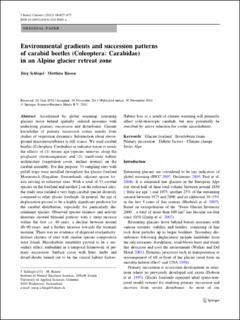Please use this identifier to cite or link to this item:
https://doi.org/10.21256/zhaw-3629Full metadata record
| DC Field | Value | Language |
|---|---|---|
| dc.contributor.author | Schlegel, Jürg | - |
| dc.contributor.author | Riesen, Matthias | - |
| dc.date.accessioned | 2018-05-03T14:33:36Z | - |
| dc.date.available | 2018-05-03T14:33:36Z | - |
| dc.date.issued | 2012 | - |
| dc.identifier.issn | 1366-638X | de_CH |
| dc.identifier.issn | 1572-9753 | de_CH |
| dc.identifier.uri | https://digitalcollection.zhaw.ch/handle/11475/5745 | - |
| dc.description | Erworben im Rahmen der Schweizer Nationallizenzen (http://www.nationallizenzen.ch) | de_CH |
| dc.description.abstract | Accelerated by global warming, retreating glaciers leave behind spatially ordered moraines with underlying primary succession and disturbance. Current knowledge of primary succession comes mainly from studies of vegetation dynamics. Information about above-ground macroinvertebrates is still scarce. We used carabid beetles (Coleoptera; Carabidae) as indicator taxon to assess the effects of (1) terrain age (species turnover along the proglacial chronosequence) and (2) small-scale habitat architecture(vegetation cover, surface texture) on the carabid assembly. For this purpose, 33 sampling sites with pitfall traps were installed throughout the glacier foreland Morteratsch (Engadine, Switzerland), adjacent sparse forests serving as reference sites. With a total of 33 carabid species on the foreland and another 2 on the reference sites, the study area yielded a very high carabid species diversity compared to other glacier forelands. In general, the age of deglaciation proved to be a highly significant predictor for the carabid distribution, especially for particularly discriminant species. Observed species richness and activity densities showed bimodal patterns with a steep increase within the first ca. 40 years, a decline between around 40-90 years, and a further increase towards the terminal moraine. There was no evidence of dispersal-stochasticity: distinct clusters of sites with similar species composition were found. Microhabitat suitability proved to be a secondary effect, embedded in a temporal framework of primary succession. Surface cover with litter, herbs and dwarf-shrubs turned out to be the crucial habitat factors. Habitat loss as a result of climate warming will primarily affect cold-stenotopic carabids, but may potentially be absorbed by active selection for cooler microhabitats. | de_CH |
| dc.language.iso | de | de_CH |
| dc.publisher | Springer | de_CH |
| dc.relation.ispartof | Journal of Insect Conservation | de_CH |
| dc.rights | Licence according to publishing contract | de_CH |
| dc.subject | Primary succession | de_CH |
| dc.subject | Invertebrate fauna | de_CH |
| dc.subject | Swiss alps | de_CH |
| dc.subject | Climate change | de_CH |
| dc.subject.ddc | 577: Ökologie | de_CH |
| dc.subject.ddc | 590: Tiere (Zoologie) | de_CH |
| dc.title | Environmental gradients and succession patterns of carabid beetles (Coleoptera: Carabidae) in an alpine glacier retreat zone | de_CH |
| dc.type | Beitrag in wissenschaftlicher Zeitschrift | de_CH |
| dcterms.type | Text | de_CH |
| zhaw.departement | Life Sciences und Facility Management | de_CH |
| zhaw.organisationalunit | Institut für Umwelt und Natürliche Ressourcen (IUNR) | de_CH |
| dc.identifier.doi | 10.21256/zhaw-3629 | - |
| dc.identifier.doi | 10.1007/s10841-011-9448-x | de_CH |
| zhaw.funding.eu | No | de_CH |
| zhaw.issue | 5 | de_CH |
| zhaw.originated.zhaw | Yes | de_CH |
| zhaw.pages.end | 675 | de_CH |
| zhaw.pages.start | 657 | de_CH |
| zhaw.publication.status | publishedVersion | de_CH |
| zhaw.volume | 16 | de_CH |
| zhaw.publication.review | Peer review (Publikation) | de_CH |
| zhaw.webfeed | Umweltplanung | de_CH |
| Appears in collections: | Publikationen Life Sciences und Facility Management | |
Files in This Item:
| File | Description | Size | Format | |
|---|---|---|---|---|
| 10.1007_s10841-011-9448-x.pdf | 1.04 MB | Adobe PDF |  View/Open |
Show simple item record
Schlegel, J., & Riesen, M. (2012). Environmental gradients and succession patterns of carabid beetles (Coleoptera: Carabidae) in an alpine glacier retreat zone. Journal of Insect Conservation, 16(5), 657–675. https://doi.org/10.21256/zhaw-3629
Schlegel, J. and Riesen, M. (2012) ‘Environmental gradients and succession patterns of carabid beetles (Coleoptera: Carabidae) in an alpine glacier retreat zone’, Journal of Insect Conservation, 16(5), pp. 657–675. Available at: https://doi.org/10.21256/zhaw-3629.
J. Schlegel and M. Riesen, “Environmental gradients and succession patterns of carabid beetles (Coleoptera: Carabidae) in an alpine glacier retreat zone,” Journal of Insect Conservation, vol. 16, no. 5, pp. 657–675, 2012, doi: 10.21256/zhaw-3629.
SCHLEGEL, Jürg und Matthias RIESEN, 2012. Environmental gradients and succession patterns of carabid beetles (Coleoptera: Carabidae) in an alpine glacier retreat zone. Journal of Insect Conservation. 2012. Bd. 16, Nr. 5, S. 657–675. DOI 10.21256/zhaw-3629
Schlegel, Jürg, and Matthias Riesen. 2012. “Environmental gradients and succession patterns of carabid beetles (Coleoptera: Carabidae) in an alpine glacier retreat zone.” Journal of Insect Conservation 16 (5): 657–75. https://doi.org/10.21256/zhaw-3629.
Schlegel, Jürg, and Matthias Riesen. “Environmental gradients and succession patterns of carabid beetles (Coleoptera: Carabidae) in an alpine glacier retreat zone.” Journal of Insect Conservation, vol. 16, no. 5, 2012, pp. 657–75, https://doi.org/10.21256/zhaw-3629.
Items in DSpace are protected by copyright, with all rights reserved, unless otherwise indicated.